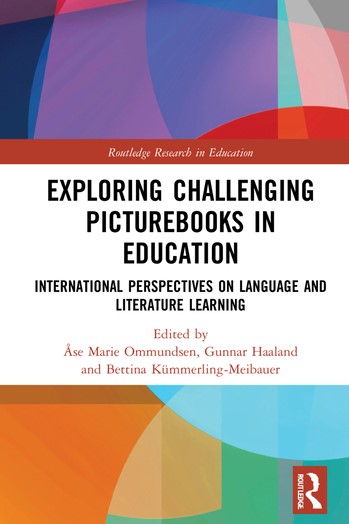- Contributor
- Editors
- Publisher
- Year
- ISBN
- Language
- Janice Bland
- Å.M. Ommundsen, G. Haaland & B. Kümmerling-Meibauer
- Routledge
- 2021
- 9780367856250
- English
What should children and students read? This volume explores challenging picturebooks as learning materials in early childhood education, primary and secondary school, and even universities. It addresses a wide range of thematic, cognitive, and aesthetic challenges and educational affordances of picturebooks in various languages and from different countries.
Written by leading and emerging scholars in the field of picturebook studies and literacy research, the book discusses the impact of challenging picturebooks in a comprehensive manner and combines theoretical considerations, picturebook analyses, and empirical studies with children and students. It introduces stimulating picturebooks from all continents and how they are used or may be used in educational settings and contexts. The chapters touch on subjects like reading promotion, second-language acquisition, art education, interdisciplinary learning, empathy development, minority issues, and intercultural competence. Moreover, they consider relevant aspects of the educational environments, such as the inclusion of picturebooks in the curriculum, the significance of school libraries, and the impact of publishers.
Exploring Challenging Picturebooks in Education sheds new light on the multiple dimensions relevant to investigating the impact of picturebooks on learning processes and the development of multimodal literacy competencies. It thus makes a significant contribution to the growing area of picturebook research and will be key reading for educators, researchers, and post-graduate students in the field of literacy studies, children’s literature, and education research.
In the context of language education, employing the picturebook as a literary text will be a challenge in many if not all senses of the word. Even in wealthier countries most schools do not have well-stocked libraries, so that accessing appealing, suitable, and sufficiently challenging English-language picturebooks that are not too complex linguistically for second language learners is also a huge hurdle. This chapter questions whether the most suitable picturebooks for ELT – texts that are more challenging than the coursebooks currently in use – can offer inspiring opportunities for a literary apprenticeship that requires cognitive and affective challenge, and may lead to in-depth learning. ELT now often spans as many as ten or twelve years of schooling, so the content and educational affordances of the language-learning space in the curriculum is more important than ever before.


